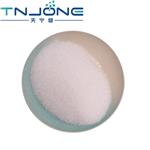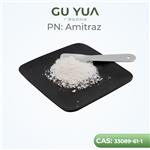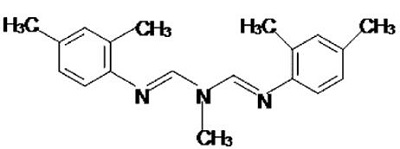- Amitraz
-

- $0.00 / 1kg
-
2024-04-08
- CAS:33089-61-1
- Min. Order: 1kg
- Purity: 99%
- Supply Ability: 100kg
- Amitraz
-

- $10.00 / 1kg
-
2024-03-08
- CAS:33089-61-1
- Min. Order: 1kg
- Purity: 99%
- Supply Ability: 1000kg
- Amitraz
-

- $6.50 / 25Kg/Drum
-
2023-12-12
- CAS:33089-61-1
- Min. Order: 1KG
- Purity: 96%
- Supply Ability: 20TONS
Related articles - What is Amitraz?
- Amitraz is a contact broad-spectrum Formamidine insecticide, which is a moderately toxic acaricide. In 1971, Palmer reported i....
- Jan 9,2020
|
| | Amitraz Chemical Properties |
| Melting point | 86-87°C | | Boiling point | 425.25°C (rough estimate) | | density | 1.1280 | | vapor pressure | 3.4×10-4 Pa (25 °C) | | refractive index | 1.5892 (estimate) | | storage temp. | Sealed in dry,Store in freezer, under -20°C | | solubility | DMF: 30 mg/ml; DMF:PBS (pH 7.2) (1:2): 0.33 mg/ml; DMSO: 20 mg/ml; Ethanol: 2 mg/ml | | pka | 4.2 (weak base) | | Water Solubility | 0.08 mg l-1 | | form | Powder/Solid | | color | White | | λmax | 247nm(lit.) | | Merck | 14,486 | | InChIKey | QXAITBQSYVNQDR-ZIOPAAQOSA-N | | CAS DataBase Reference | 33089-61-1(CAS DataBase Reference) | | NIST Chemistry Reference | Amitraz(33089-61-1) | | EPA Substance Registry System | Amitraz (33089-61-1) |
| Hazard Codes | Xn;N,N,Xn | | Risk Statements | 22-43-48/22-50/53 | | Safety Statements | 22-24-36/37-60-61 | | RIDADR | UN 3077 | | WGK Germany | 3 | | RTECS | ZF0480000 | | HazardClass | 9 | | PackingGroup | III | | HS Code | 29252900 | | Hazardous Substances Data | 33089-61-1(Hazardous Substances Data) | | Toxicity | LD50 in male rats, female mice, rabbits, guinea pigs, bobwhite quail (mg/kg): 800, >1600, >100, >400, 788 orally; LD50 in rabbits, male rats (mg/kg): >200, >1600 dermally; LC50 (48 hr) in rainbow trout, Japanese carp: 3.3, 1.2 ppm (Labonne) |
| | Amitraz Usage And Synthesis |
| Overview | Amitraz is a formamidine pesticide widely used as an insecticide and acaricide. Formamidine pesticides were developed in the late 1950s and early 1960s due to the development of resistances to conventional insecticides. The two formamidines primarily marketed and most widely used are chlordimeform and amitraz. Amitraz (1,5-di (2,4-dimethylphenyl)-3-methyl-1, 3, 5-triazapenta1,4-diene) (Figure 1) was first patented in 1971, registered as a pesticide of technical grade in 1975[1] and marketed in 1981.
Amitraz is an insecticide used to prevent tick and mite infestation and is in common use around the world. Amitraz is applied to cattle[2] and sheep in dip baths at concentrations of 0.025%[3], to dogs from collars impregnated with 0.025% amitraz, or by topical application in a bath of 0.05% amitraz[4], to pigs in sprays containing 12.5%, and to cotton and hops[5] by spraying 20% solutions of amitraz from aeroplanes and ground sprinklers. In addition, amitraz is used to control psylla infestations of pears[6]. Human exposure to amitraz occurs when diluting the concentrate obtained from the manufacturer, when applying the amitraz to crops or animals, and when working in amitraz-treated areas, for example pear orchards or cotton fields[1].
Different agencies have evaluated amitraz toxicity and the lethal dose 50 (LD50) or lethal concentration 50(LC50) values on acute toxicity studies[1, 7]. The EPA (Environmental Protection Agency), according to acute toxicity studies, classifies amitraz as Class III-slightly toxic by the oral and inhalation routes, as Class II-moderately toxic by the dermal route, and as Class IV-not a dermal irritant and only slightly irritant to the eyes and not a dermal sensitizer[1].
Amitraz is rapidly absorbed, distributed, metabolized, and eliminated primarily via urine when administered orally to mammals.[1, 7] No differences have been described between species and genders in the rates and routes of excretion. In all species studied, 55−74% of the dose was excreted in the urine within the first 24 h after dosing[1, 7]. The degradation products present in the urine include N′-[2,4-dimethylphenyl]-Nmethylformamidine (BTS-27271), 2,4-dimethylformanilide (BTS-27919), 2,4-dimethylaniline (BTS-24868), 4-formamido3-methylbenzoic acid (BTS-39098), 4-amino-3-methylbenzoic acid (BTS-28369), and several unknown metabolites.[8] Moreover, the spectrum of metabolites observed was similar in all species studied. BTS-27271 and BTS-27919 are the main metabolites of amitraz and a cause of concern due to the content of the 2,4-dimethylaniline moiety, which could lead to developmental and genotoxic effects.[1, 2] Furthermore, BTS-27271 has been found to be more potent than amitraz with regard to its miticidal activity and mammalian toxicity. The action of these metabolites has been described only for some of the mechanisms and effects of amitraz; thus, further studies are needed to determine their participation in the rest of the mechanisms and effects[9, 10].

Figure 1 the chemical structure of amitraz | | Indication and contradiction | Amitraz is indicated for animal use against mites, lice and ticks for cattle, swine and sheep. For dogs, it is used against ticks and mite[11]. It was reported as the drug of choice in the treatment of localized and generalized demodicosis in dogs[11]. Along with macrocyclic lactones such as milbemycin oxime, ivermectin, moxidectin, and doramectin, amitraz is still recommended for the treatment of generalized canine demodicosis, although it is not very efficient in adult-onset demodicosis cases[12]. Chesney (1989) also reported the use of amitraz in the treatment of demodicosis in cats[13]. Gunaratnam et al. (1983)[14] evaluated amitraz toxicity in cats, and concluded that low concentrations, around 0,0125% are capable of generating moderate toxic effects, especially anorexia. The toxic effects are even more evident in cats, due to their licking habit, resulting in a higher intake of the product. However, it is possible to use amitraz topically in healthy cats, respecting the appropriate contraindications common to the other species, which is to avoid the use in diabetic, hypothermic, and cardiac patients.
Amitraz is contraindicated in horses due to the risk of hypomotility and intestinal atony, leading to severe intestinal impaction[13, 14]. It has been also observed, besides the intestinal symptoms, the occurrence of neurologic signs as drowsiness, decreased cranial nerve reflexes and ataxia in horses submitted to the experimental use of amitraz. This substance is contraindicated for patients with extended skin injuries, which could lead to an over absorption, favoring intoxication.
| | Pharmacokinetics and pharmacodynamic | Amitraz is quickly hydrolyzed in an acid environment when it is orally administrated, due to its instability in this environment. The hydrolysis in a low pH generates the compound 2,4-dimethylphenyl formamide, which is stable in an acid environment. This substance can still be hydrolyzed, generating 2,4-dimethylaniline[15]. Absorption is effective through the skin, which may be major or minor depending on its integrity, the occurrence of injuries, and inflammation. After reaching the blood stream, the drug reaches the highest plasmatic level in up to two hours. The biotransformation occurs in the liver, generating the active metabolite BTS 27271, the most important pharmacologically, because it acts directly in the regulation of the insulin and glucagon secretion by binding to the α2A and α2D-adrenergic receptors, inhibiting insulin and stimulating glucagon secretion, resulting in hyperglycemia. Metabolites are excreted in bile and urine.
In insects, formamidines such as chlordimeform and amitraz operate its toxic effects by interacting with octopaminergic receptors in the central nervous system[16]. The mechanisms by which the deleterious effects of amitraz in mammals are determined are based on its agonistic action on α2-adrenergic receptors and inhibitory action over the monoamine oxidase (MAO), but there are reports of various action pathways, such as: H1 histamine receptor inhibition, prostaglandin synthase inhibition, adenylyl cyclase inhibition, voltage-gated calcium channels activation, reactive oxygen species generation, cell death induction and endocrine disruptions. Amitraz is also related to the emergence of neurotoxic effects and modifications in the reproductive sphere in rats[17].
| | Reference |
- USEPA (United States Environmental Protection Agency) (1996)
- McDougall K and Lewis I (1984). Aust Vet J 61,137–140.
- Eamens G, Spence S and Turner M (2001) Aust Vet J 79,703–706.
- Shaw S and Foster A (2000) Aust Vet J 78,243–244.
- Weichel L and Nauen R (2003) Pest Manage Sci 59,991–998.
- Schaub L, Sardy S and Capkun G (2002) Pest Manage Sci 58,959–963.
- JMPR. Pesticide Residues in Food−1998, Evaluations Part II: Toxicological WHO/PCS/99.18, 1998
- Knowles, C. O., and Benezet, H. J. (1981) J. Environ. Sci. Health, Part B 16, 547−555.
- Schuntner, C. A., and Thompson, P. G. (1978) Aust. J. Biol. Sci. 31, 141−148.
- Pass, M. A., and Mogg, T. D. (1991) Comp. Biochem. Physiol., Part C: Pharmacol., Toxicol. Endocrinol. 99, 169−172.
- Folz, S.D et al. Veterinary Parasitology, 16(3-4): 335–341, 1984.
- Mueller, R.S. Veterinary Dermatology, 15: 75-89, 2004
- Chesney, C.J. Journal of Small Animal Practice, 30(12): 689-695, 1989
- Gunaratnam, P.; Wilkinson, G.T.; Seawright, A.A. Australian Veterinary Journal, 60(9): 278–279, 1983.
- Pierpoint, A.C.; Hapeman, C.J.; Torrents, A. Journal of Agricultural and Food Chemistry's. 45(5): 1937-1939,1997.
- Chen, A.C.; He, H.; Davey, R.B. Veterinary Parasitology, 148: 379-383, 2007.
- Del Pino, J.; et al Chemical Research in Toxicology, 28(6): 1073-1094, 2015.
- Costa, L. G., Wu, D. S., Olibet, G., and Murphy, S. D. (1989) Neurotoxicol. Teratol. 11, 405−411.
- Douglas, W. W. (1980) Histamine and 5-Hydroxytryptamine (Serotonin) and Their Antagonist, in The Pharmacological Basis of Therapeutics., pp 609−646, Macmillan, New York.
- Levitt, P., et al. (1997) Trends Neurosci. 20, 269−274.
- Fajardo, A. M., et al (2014) Cancers 6, 436−458.
- Shin, D. H., and Hsu, W. H. (1994) Toxicol. Appl. Pharmacol. 128, 45−49.
- Radakovic, M., et al J. Biosci. (New Delhi, India) 38, 53−62.
- Gregorc, A., and Bowen, I. D. (2000) Cell Biol. Int. 24, 319−324.
| | Chemical Properties | Beige to Pale Yellow Solid | | Chemical Properties | Amitraz forms colorless needle-like crystals.
Liquid formulations may contain flammable organic solvents. | | Originator | Aludex,Hoechst Roussel
Vet Ltd. | | Uses | Acaricide; insecticide. | | Uses | coccidiostat, antiplatelet | | Uses | Amitraz is used for the control of all stages of mites and insects
such as aphids and whitefly, and the eggs and first instar larvae of
Lepidoptera on fruit, cotton and vegetables. It is also used in honey bee
hives and for the control of ticks, mites and lice on domestic and farm
animals. | | Uses | Amitraz is an antiparasitic used to control red spider mites, leaf miners and scale insects. This compound is active by inhibiting the targets monoaminooxidase enzyme. | | Definition | ChEBI: A tertiary amino compound that is 1,3,5-triazapenta-1,4-diene substituted by a methyl group at position 3 and 2,4-dimethylphenyl groups at positions 1 and 5. | | Manufacturing Process | A mixture of 55.1 g 2,4-dimethylaniline hydrochloride, 83.7 g ptoluenesulphonyl
chloride and 150 ml N-methylformamide was stirred with
occasional cooling to maintain the temperature at 20°-35°C. When the
exothermic reaction had subsided, the mixture was stirred at room
temperature for 4 h, poured into a mixture of ice and water, and basified with
10 N sodium hydroxide solution, keeping the temperature of the mixture below 10°C. The precipitated solid was filtered, washed with water until free
from alkali, dried at room temperature, to give N-2,4-dimethylphenyl-N'-
methylformamidine, melting point 75°-76°C (recrystallized from cyclohexane).
A solution of 19.4 g N-2,4-dimethylphenyl-N'-methylformamidine and 0.3 g ptoluenesulphonic
acid in 195 ml dry xylene was refluxed under anhydrous
conditions for 48 h, causing the evolution of methylamine. The xylene was
distilled off under reduced pressure to give 1,5-di-(2,4-dimethylphenyl)-3-
methyl-1,3,5-triaza-penta-1,4-diene, melting point 88°-89°C (crystallized
twice from isopropyl). | | Therapeutic Function | Acaricide, Scabicide, Tickicide, Appetite stimulant | | General Description | White monoclinic crystals. Melting point 187-189°F (86-87°C). Insoluble in water. Used as an acaricide, insecticide and treatment of demodectic mange in dogs. | | Air & Water Reactions | Insoluble in water. | | Reactivity Profile | Unstable in acid. | | Agricultural Uses | Insecticde, Acaricide, Veterinary medicine: Registered for control of pear psylla on pears, whitefly and mites on pears and cotton; cattle, dogs, sheep, and
hog dip to control ticks, mange mites, lice and other pests.
Not permitted on apples. Used to control red spider mites,
leaf miners, scale insects, and aphids. Also used on cotton
to control bollworms, white fly, leaf worms, and tobacco
budworms. Not registered for use in EU countries | | Trade name | AAZDIENO®; ACARAC®; ACADREX®;
ARMY®; AZODIENO®; BAAM®; BOOTS BTS
27419®; BTS 27,419®; BUMETRAN®; COYOTE®;
DANICUT®; ECTODEX®; EDRIZAN®; EDRIZAR®;
GARIAL®; ISTAMBUL®; MITABAN®; MITAC®;
OVASYN®; OVIDREX®; PARSEC®; ROTRAZ®;
SENDER®; TAC-PLUS®; TACTIK®; TRIATIX®;
TRIATOX®; TUDY®; VAPCOZIN TAKTIC®; UPJOHN
U-36059® | | Pharmacology | The mechanism of action of amitraz has not been
completely elucidated, and, presently, a dual mode of
action appearsmost likely. Firstly, the enzymemonoamine
oxidase, which metabolizes neurotransmitter amines in
mites and ticks, is inhibited. Secondly, octopamine
receptors in the central nervous system of ectoparasites
are activated by amitraz, thereby modifying tonic muscle
contractions. The effect of amitraz is to induce increased
neuronal activity, abnormal behavior, detachment, and
death of mites and ticks. | | Potential Exposure | Those engaged in the manufacture, formulation
and application of this insecticide and acaricide. A
rebuttable presumption against registration for amitraz was
issued on April 6, 1977 by United States Environmental
Protection Agency on the basis of oncogenicity.
Incompatibilities: Keep away from strong oxidizers and
strong acids. Acids may render this material unstable. | | Veterinary Drugs and Treatments | In dogs, amitraz solution is used topically primarily in the treatment of generalized demodicosis. A topical spot-on solution (ProMeris?
for Dogs) and a collar (Preventic?) are available for treatment and prevention of flea and tick infestation. It is also used as a general insecticidal/
miticidal agent in several other species (see label information). The pharmacologic action of amitraz is not well understood, but
it is a monoamine oxidase (MAO) inhibitor (in mites) and may have effects on the CNS of susceptible organisms. It apparently also possesses
alpha-2 adrenergic activity and inhibits prostaglandin synthesis. Amitraz can cause a significant increase in plasma glucose levels,
presumably by inhibiting insulin release via its alpha2-adrenergic activity. Yohimbine (alpha2 blocker) or atipamezole can antagonize this
effect. | | Metabolic pathway | 14C-Amitraz is applied on lemons grown under
glasshouse conditions at final harvest and the applied
radioactivity is quantitatively recovered, predominantly
in the peel (86%). The total residue at harvest
contains amitraz, N-methyl-N'-(2,4-xylyl)formamidine,
and formyl-2',4'-xylydine and conjugates of 4-amino-
m-toluic acid and the conjugated metabolites which
are convertible to 2,4-xylidine. Amitraz is readily
hydrolyzed at low pH values, forming acid-stable
formyl-2,4-xylydine which can be further hydrolyzed to
2,4-xylidine. | | Metabolism | Amitraz is poorly absorbed when applied topically to
animals. By contrast, orally administered amitraz is
rapidly and extensively absorbed. The metabolism and
excretion of amitraz are also rapid. It is hydrolyzed to
N-(2,4-dimethylphenyl)-N -methyl formamidine and 2,4-
dimethyl formamidine and the final product, 4-amino-3-
methylbenzoic acid, is converted to non-toxic conjugates.
The latter are excreted in the urine and, to a lesser extent,
in bile. | | Shipping | UN2763 Triazine pesticides, solid, toxic, Hazard
Class: 6.1; Labels: 6.1-Poisonous materials. | | Degradation | Amitraz is readily hydrolysed at acidic pH but is relatively stable under
alkaline conditions. Its DT50 values at 25 °C at pH 5,7 and 9 are given as
2.1,22.1 and 25.5 hours, respectively (PM). A recent study (Pierpoint et aE.,
1997) as part of the development of a vat management and waste disposal
programme for animal dips describes the kinetics and mechanism of
hydrolysis of amitraz in detail. Pseudo-first-order rate constants are given
for six pH values between 3.24 and 9.12. The DT50 values at pH values
3.24, 5.09 and 9.12 were respectively 0.4, 8.7 and 112 hours. The reaction
was mainly acid-catalysed with a small unassisted component. There was
no base catalysis. One of the primary products (Scheme 1) was N-2,4
dimethylphenyl-N-methylformamidine( 2); however, at low pH this was
not detected because it was rapidly hydrolysed to 2,4-dimethylphenylformamide
(3). Some direct hydrolysis of amitraz to product 3 was
also seen. The latter underwent slow base-catalysed hydrolysis to 2,4
dimethylaniline (4). This was a much slower reaction with a DT50 (pH
9.12) of about 300 days. | | Toxicity evaluation | Amitraz displays serotonin (5-hydroxytryptamine) blocking
activity and a2-adrenoceptor agonist activity in animals.
The clinical signs associated with intoxication in
dogs include sedation, bradycardia, hypotension, hyperglycaemia,
hypothermia, and mydriasis. The specific antidote
for animal toxicity is the a2-adrenoceptor antagonist,
yohimbine. The toxicity profile of amitraz in the horse
includes transient sedation and intestinal stasis that can
progress to impaction colic (79). For this reason, amitraz
is not approved for use in this species in any country. | | Incompatibilities | Those engaged in the manufacture, formulation
and application of this insecticide and acaricide. A
rebuttable presumption against registration for amitraz was
issued on April 6, 1977 by United States Environmental
Protection Agency on the basis of oncogenicity.
Incompatibilities: Keep away from strong oxidizers and
strong acids. Acids may render this material unstable. | | Waste Disposal | In accordance with 40CFR
165 recommendations for the disposal of pesticides and
pesticide containers. Must be disposed properly by following
package label directions or by contacting your local or
federal environmental control agency, or by contacting
your regional EPA office. |
| | Amitraz Preparation Products And Raw materials |
|